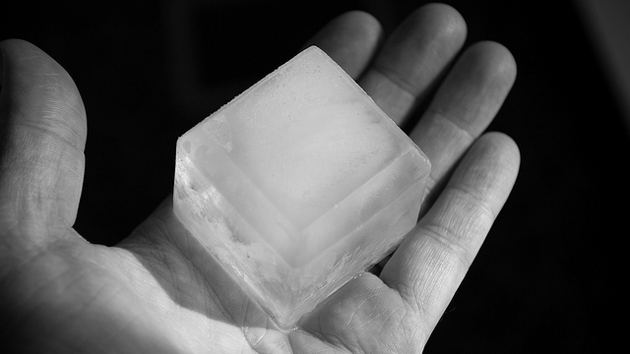
Ice, ice, babyRobert S. Donovan/Flickr Creative Commons
If you want to understand the latest trend in craft cocktails, you could do worse than to listen to Outkast. What’s cooler than being cool is indeed ice cold. Specifically, it’s stored at minus-2 degrees, sculpted with a Japanese band saw, and retails for $1 a cube.
Yes, artisanal ice is now a thing. In hipster meccas from Portland to Williamsburg, bars are serving up their drinks on extra-dense, extra-clear cubes, produced through a laborious process of freezing and carving. Cocktail connoisseurs swear the difference in flavor is worth the extra effort: In addition to being more aesthetically pleasing, the cubes’ density and relatively large size mean they melt more slowly and dilute your drink less. But there’s evidence that the fancy ice might not be the coolest thing ever to happen to the environment.
Demand for artisanal ice grew out of the past decade’s “cocktail renaissance“—the rise of small-batch liquor producers, the rediscovery of pre-Prohibition recipes, and an increasing emphasis on fresh, homemade ingredients. The roughly two dozen establishments buying from DC-based distributor Favourite Ice include foodie destinations like Jaleo, a tapas bar, and the Capitol Hill seafood restaurant Hank’s Oyster Bar. Favourite Ice co-owner Joseph Ambrose says that since he founded the business in 2012, he’s had a steady stream of orders. “I basically haven’t slept in two years,” he laughs.
There are at least 20 artisanal ice suppliers in the United States. Like many of them, Ambrose makes his product in a special type of freezer called a Clinebell machine—the same device that ice sculptors use to form the blocks they carve into statues for weddings and bar mitzvahs. Most freezers chill water from the top down, which traps air bubbles under the upper layer of ice and leads to a cloudy cube. Clinebells cool from the bottom up, circulating the top layer of water to get rid of bubbles until it’s all frozen. Every three days, the machine spits out two 300-pound, crystal-clear chunks of ice, which Ambrose and his business partner then break down with saws and deliver to clients around the city.
Ambrose says his average yield from a single block is about 600 two-inch cubes. For Charles Hartz, owner of Portland’s PDX Ice, it’s closer to 400. (The difference may be due to the men’s choice of cutting implements; Hartz uses various Japanese tools, while Ambrose relies on a saw that was designed to hack up cow carcasses.) When business peaks in summer and autumn, that means Hartz is making roughly 1,500 pounds of ice a week. His retail price is a dollar a cube; bulk buyers pay 50 cents a cube.
Hartz got into artisanal ice-making by accident. In its original incarnation, PDX Ice was an ice sculpture company, and when the general manager of the Imperial Restaurant asked to buy a solid block of ice one day in 2013, Hartz didn’t immediately understand why he wanted it.
Since then, artisanal ice orders have come to account for half of Hartz’s business. He says he caught on to why bartenders were interested in his product after tasting the drinks they created with it. “When you freeze ice in your freezer, you’re absorbing whatever’s in there—food, whatever,” he says. Drinks made with his ice, he says, have no weird freezer flavors.
But the tradeoff for better taste may be worse energy efficiency. According to Pete Palm, vice president of sales at Western Pacific Distributors—one of California’s major food service equipment wholesalers—a Clinebell has to run for more than three days to make the amount of ice a regular restaurant ice machine could produce in one day. “If I do some quick calculations on the lbs of ice and the [horsepower] rating I come to the conclusion that it does not meet what would be considered an energy star unit,” Palm wrote in an email to Mother Jones. (Energy Star is an EPA standard for energy-efficient consumer products; most commercial ice makers are Energy Star-certified.)
Artisanal ice makers also have to deliver their product to their customers, which means packing it in dry ice and carting it around in a van. And their high standards for the shape of their blocks can exacerbate the inefficiency. If Hartz finds a block with a chip or a crack, he says, he won’t use it. “I’m kind of particular,” he admits.
Hartz argues that there’s no better way to produce the two-inch cubes that fit rocks glasses best. Commercial ice machines don’t make cubes with those dimensions, and though it’s possible to create them with silicon molds, “the result will still be a cloudy ice product. It’s just not that appealing in drinks.”
Regardless of its environmental impact, artisanal ice probably isn’t going away anytime soon. Ambrose says he’s even started making house calls. He recently delivered a set of three-inch cubes to a man in the DC area.
“We got there and he had a very expensive Scotch collection,” Ambrose said. “It was kind of like, ‘Oh, this makes sense.'”











